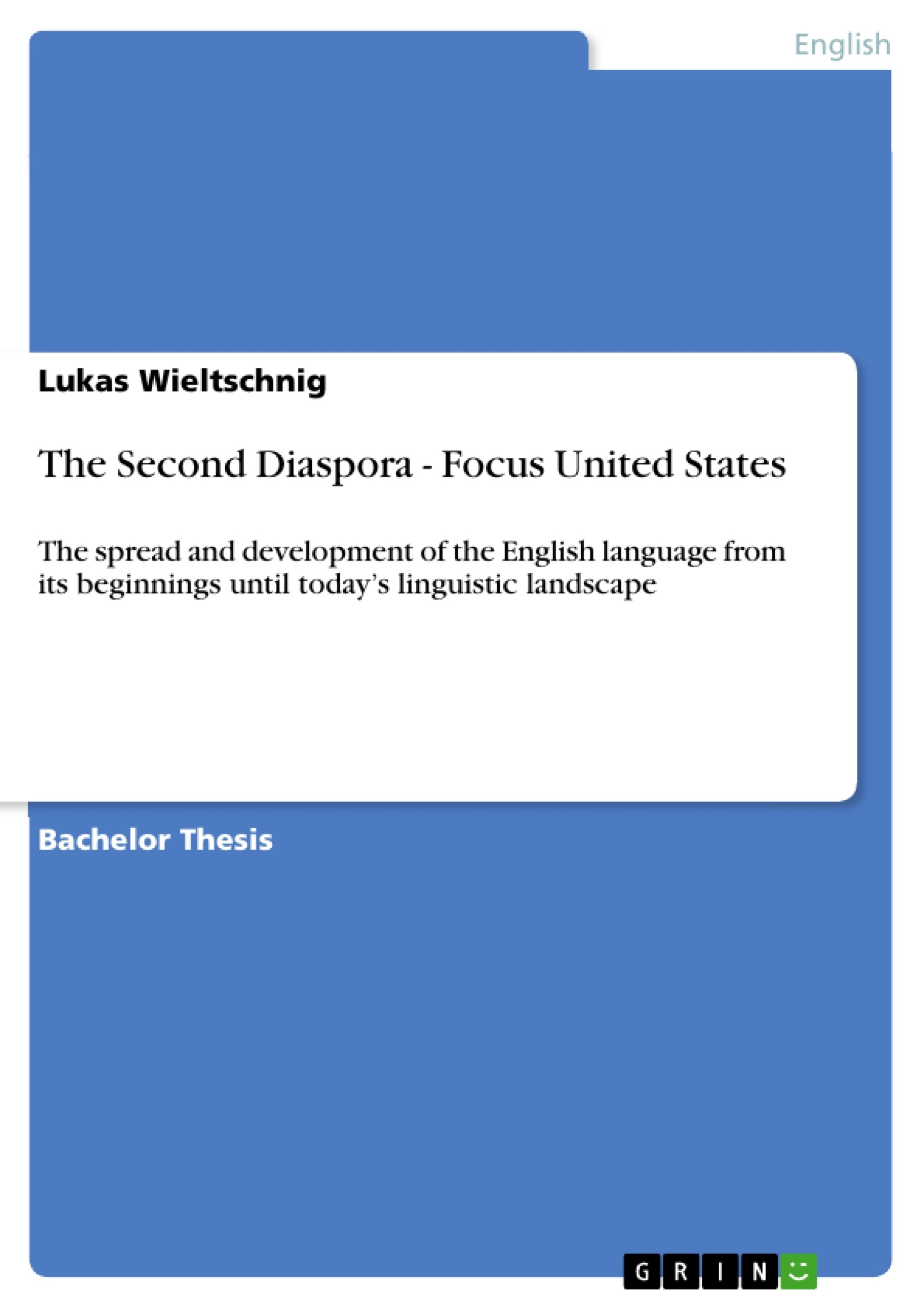At first, it will be discussed which countries or regions are included in Kachru’s (2006) classification of the three diasporas, with the second one being outlined in more detail due to including the country of focus of this paper, the United States.
The first part of the paper will then focus on the historical spread and development of the English language in the United States. This analysis will begin with the first settlers arriving in 1607 illustrating the first steps of the language on the new continent. It will then further be argued how the first settlers began mixing their way of speaking from their respective country or region of origin and how the linguistic landscape was further changed once the first non-English speaking immigrant began arriving in the nation. Historical events will also be analyzed throughout the paper in order to reach a better understanding of how the English language has been influenced by not only the country’s settlers, but also by major events taking place. These events will include the gain of further territory by war, against Spain and Mexico, by purchase, the Louisiana Purchase from France, and by expanding the borders of the nation in form of the Westward Expansion. This part will further feature a brief outline of the attempts to establish linguistic unity throughout the whole nation by trailblazers, such as Noah Webster and his dictionary.
The second part of the paper will focus on today’s linguistic landscape in the United States. An overview of multiple dialects will be provided by taking Crystal’s (2003) classification of American dialect regions into account. These chosen dialects will be analyzed in terms of how they came to be throughout the city’s or region’s history and what their future might look like. Additionally, two ethnic varieties of American English will be outlined, in order to show that the development of the English language on the American continent is not only restricted to migratory movement, but also by numerous different cultural backgrounds and heritages connected to one’s own identity. All of these dialects and varieties will be analyzed linguistically as well with some distinctive features being provided to illustrate their uniqueness.
Inhaltsverzeichnis (Table of Contents)
- Introduction
- Kachru's classification of the three diasporas
- The first diaspora
- The second diaspora
- Canada
- Australia and New Zealand
- The third diaspora
- The historical spread and development of English in the United States
- Early beginnings on the new continent
- More land, more settlers, more languages
- Native population and slaves
- British and American English drifting apart?
- Search for linguistic unity
- English going west
- The beginnings of the Westward Expansion
- The Louisiana Purchase
- Expanding into Spanish-speaking territory
- The Oregon Trail
- Linguistic results of the Westward Expansion
- Generational gap
- Spanish on its way to threaten the English linguistic supremacy?
- The linguistic situation of English in the US as of today
- English in the South
- Southern American English
- Appalachian English
- Texas English
- New Orleans English
- English in the North
- New England English
- Maine English
- New York English
- Philadelphia English
- Midland English
- Midwestern English
- St. Louis English
- California English
- Arizona English
- Ethnic varieties of American English
- African American English
- Chicano English
- English in the South
- Conclusion
Zielsetzung und Themenschwerpunkte (Objectives and Key Themes)
This paper focuses on the spread and development of the English language in the United States, exploring its historical journey from the arrival of the first settlers to its current linguistic landscape. It aims to analyze how English has evolved in the US, considering factors such as historical events, migration patterns, and cultural influences.
- Kachru's classification of English diasporas and its relevance to the US
- The historical spread of English in the US, including major events and settlements
- The development of distinct American English dialects and their linguistic features
- The influence of ethnic varieties of American English on the linguistic landscape
- The interplay of language and culture in shaping the American English identity
Zusammenfassung der Kapitel (Chapter Summaries)
The paper begins by introducing Kachru's classification of English diasporas, outlining the three circles of English and their historical contexts. The second diaspora, which includes the United States, is then discussed in detail, focusing on the spread of English in Canada, Australia, and New Zealand. This overview provides a framework for understanding the historical and linguistic context of English in the US.
The paper then delves into the historical spread and development of English in the United States. It explores the early beginnings of English on the new continent, including the arrival of the first settlers and the subsequent blending of different dialects and languages. The analysis then examines how major historical events, such as the Westward Expansion, the Louisiana Purchase, and the arrival of non-English speaking immigrants, have shaped the linguistic landscape of the US.
Finally, the paper discusses the contemporary linguistic situation of English in the US, focusing on the development of distinct regional dialects and the influence of ethnic varieties. It analyzes the linguistic features of various dialects, such as Southern American English, New England English, and African American English, highlighting the unique characteristics of each.
Schlüsselwörter (Keywords)
The paper explores the spread and development of English in the United States, focusing on themes such as linguistic diversity, historical events, regional dialects, ethnic varieties, and the interplay of language and culture. Key concepts include Kachru's classification of English diasporas, the Westward Expansion, the Louisiana Purchase, the founder effect, American English dialects, and African American English.
- Quote paper
- Lukas Wieltschnig (Author), 2021, The Second Diaspora - Focus United States, Munich, GRIN Verlag, https://www.grin.com/document/1380356




